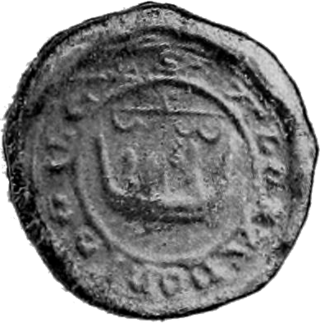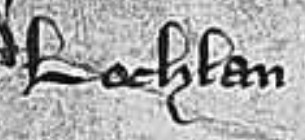
Malise IV of Strathearn was a Scottish nobleman, the seventh known ruler of Strathearn. He was an ardent supporter of King Robert the Bruce, in contrast to his father, Malise III, who sided with Edward I of England.
The Battle of Renfrew was fought between the Kingdom of the Isles and the Kingdom of Scotland in 1164, near Renfrew, Scotland. The men of the Isles, accompanied by forces from the Kingdom of Dublin, were commanded by Somerled. The identity of the Scottish commander is unrecorded and unknown. Herbert, Bishop of Glasgow, Baldwin, Sheriff of Lanark/Clydesdale, and Walter fitz Alan, Steward of Scotland are all possible candidates for this position. The battle was a disaster for the Islesmen and Dubliners. Somerled was slain in the encounter, apparently by local levies, and his forces were routed.

Eóghan MacDubhghaill was a 13th-century Scottish nobleman and warrior who was styled "King of the Isles", "Lord of Argyll". He was the son of Donnchadh, son of Dubhghall, son of Somhairle mac Gille Brighde.

Aonghus Óg Mac Domhnaill, or Angus Og MacDonald, was a fourteenth-century Scottish magnate and chief of Clann Domhnaill. He was a younger son of Aonghus Mór mac Domhnaill, Lord of Islay. After the latter's apparent death, the chiefship of the kindred was assumed by Aonghus Óg's elder brother, Alasdair Óg Mac Domhnaill.
Dubgall mac Somairle was King of the Isles. He was a son of Somairle mac Gilla Brigte and Ragnhildr Óláfsdóttir. Dubgall was a leading figure of Clann Somairle, and the eponymous ancestor of Clann Dubgaill. Dubgall's career is obscure, and little is certain of his life.

Aonghus Mór mac Domhnaill was a leading figure in the thirteenth-century kingdoms of the Isles and Scotland. He was a son of Domhnall mac Raghnaill, the eponym of Clann Domhnaill, a branch of Clann Somhairle. Aonghus Mór appears to have succeeded his father in the mid part of the thirteenth century. At the time, the rulers of the Isles were fiercely independent of the Scottish Crown, and owed nominal allegiance to the distant Norwegian Crown. Aonghus Mór's first certain appearance in the historical record seems to evince his involvement in aiding native Irish kindreds against the consolidation of Anglo-Irish authority in the north-west of Ireland. Such cooperation could have been undertaken in the context of overseas kindreds like Clann Domhnaill constructing Irish alliances to gain assistance against Scottish encroachment.
Ruaidhrí mac Raghnaill was a leading figure in the Kingdom of the Isles and a member of Clann Somhairle. He was a son of Raghnall mac Somhairle and was the eponymous ancestor of Clann Ruaidhrí. Ruaidhrí may have become the principal member of Clann Somhairle following the annihilation of Aonghus mac Somhairle in 1210. At about this time, Ruaidhrí seems to have overseen a marital alliance with the reigning representative of the Crovan dynasty, Rǫgnvaldr Guðrøðarson, King of the Isles, and to have contributed to a reunification of the Kingdom of the Isles between Clann Somhairle and the Crovan dynasty.

Alasdair Óg Mac Domhnaill was Lord of Islay and chief of Clann Domhnaill. He was the eldest son of Aonghus Mór mac Domhnaill, Lord of Islay. Alasdair Óg seems to first appear on record in 1264, when he was held as a hostage of the Scottish Crown for his father's good behaviour. During Alasdair Óg's career, the Scottish realm endured a succession crisis as a result of the unexpected death of Margaret, Maid of Norway, heir to the Scottish throne, in 1290. One of several factions that staked a claim to the throne was the Bruce kindred. Both Alasdair Óg and his father were cosignatories of the Turnberry Band, a pact that may have partly concerned the Bruces' royal aspirations.
Dubhghall mac Ruaidhrí was a leading figure in the thirteenth-century Kingdom of the Isles, on the West Coast of Scotland. He was a son of Ruaidhrí mac Raghnaill, and thus a member of Clann Ruaidhrí. Dubhgall was the last Gaelic King of Mann.

Clann Ruaidhrí was a leading medieval clan in the Hebrides and the western seaboard of Scotland. The eponymous ancestor of the family was Ruaidhrí mac Raghnaill, a principal member of Clann Somhairle in the thirteenth century. Members of Clann Ruaidhrí were factors in both the histories of the Kingdom of the Isles and the Kingdom of Scotland in the thirteenth- and fourteenth centuries. The family appears to have held power in Kintyre in the thirteenth century. By the fourteenth century, the family controlled an extensive provincial lordship stretching along the north-western Scottish coast and into the Hebrides. As a leading force in the Kingdom of the Isles, the family fiercely opposed Scottish authority. With the collapse of Norwegian hegemony in the region, the family nimbly integrated itself into the Kingdom of Scotland.
Ailéan mac Ruaidhrí was a leading figure in the thirteenth-century kingdoms of the Isles and the Scotland. He was a son of Ruaidhrí mac Raghnaill, and thus a member of the Clann Ruaidhrí branch of Clann Somhairle. Ailéan was a brother of Dubhghall mac Ruaidhrí, King of Argyll and the Isles, a significant figure who held power in the mid thirteenth century. At the time, the rulers of the Isles were fiercely independent of the Scottish Crown, and owed nominal allegiance to the distant Norwegian Crown. In 1259, Dubhghall's daughter married the son of King of Connacht, and Ailéan is recorded to have commanded the woman's tocher of one hundred and sixty gallowglass warriors.

Christina of the Isles was a fourteenth-century Scottish noblewoman. She was the daughter of Ailéan mac Ruaidhrí and a leading member of Clann Ruaidhrí. Although Ailéan had two sons, Lachlann and Ruaidhrí, both appear to have been illegitimate, whereas Christina was legitimate, and possibly a daughter of Ailéan's wife, Isabella.
Dubhghall mac Suibhne was a Scottish landholder in Argyll, and a leading member of Clann Suibhne. He was a son of Suibhne mac Duinn Shléibhe, and appears to have held lordship of Knapdale from at least the 1240s to the 1260s, and may have initiated the construction of Skipness Castle and Lochranza Castle.
Murchadh Mac Suibhne was a leading member of Clann Suibhne. He was a grandson of the family's eponymous ancestor Suibhne mac Duinn Shléibhe, and a nephew of the family's mid-thirteenth-century representative, Dubhghall mac Suibhne.

Eóin Mac Suibhne was a fourteenth-century Scottish nobleman and a leading member of Clann Suibhne. In the middle of the thirteenth century, seemingly during the 1260s, Eóin's family appears to have been ejected from its homeland in Argyll by the Stewart/Menteith kindred. It may have been during this period that members of Clann Suibhne took up residence in Ireland.
Aufrica de Connoght, also known as Affrica de Counnought, Affreca de Counnoght, Auffricia de Connaught, and Aufrica de Cunnoght, was a fourteenth-century woman who claimed to be an heiress of Magnús Óláfsson, King of Mann and the Isles, and who had some sort of connection with Simon de Montagu.
Raghnall Mac Ruaidhrí was an eminent Scottish magnate and chief of Clann Ruaidhrí. Raghnall's father, Ruaidhrí Mac Ruaidhrí, appears to have been slain in 1318, at a time when Raghnall may have been under age. Ruaidhrí himself appears to have faced resistance over the Clann Ruaidhrí lordship from his sister, Cairistíona, wife of Donnchadh, a member of the comital family of Mar. Following Ruaidhrí's demise, there is evidence indicating that Cairistíona and her powerful confederates also posed a threat to the young Raghnall. Nevertheless, Raghnall eventually succeeded to his father, and first appears on record in 1337.

Lachlann Mac Ruaidhrí was a Scottish magnate and chief of Clann Ruaidhrí. He was a free-booting participant in the First War of Scottish Independence, who remarkably took up arms against figures such as John, King of Scotland; Edward I, King of England; the Guardians of Scotland; and his near-rival William II, Earl of Ross. Lachlann disappears from record in 1307/1308, and appears to have been succeeded by his brother, Ruaidhrí, as chief of Clann Ruaidhrí.
Ruaidhrí Mac Ruaidhrí was a fourteenth-century Scottish magnate and chief of Clann Ruaidhrí. He was an illegitimate son of Ailéan mac Ruaidhrí, and is recorded to have participated in the kindred's military actions against supporters of both the English Crown and Scottish Crown. Following the apparent death of his brother, Lachlann, Ruaidhrí appears to have taken control of the kindred, and firmly aligned the family with Robert I, King of Scotland. Ruaidhrí may well be the member of Clann Ruaidhrí who is recorded slain at the Battle of Faughart in support of the Bruce cause in Ireland. After his death, Ruaidhrí's half-sister, Cairistíona, attempted to transfer the Clann Ruaidhrí territories outside the family. Ruaidhrí was survived by a daughter, Áine, and an illegitimate son, Raghnall. The latter fended off Cairistíona's actions and succeeded to the chiefship of Clann Ruaidhrí.
Domhnall Mac Domhnaill, also known as Domhnall of Islay and Domhnall of the Isles, was a fourteenth-century Scottish nobleman. He appears to have been a member of Clann Domhnaill. First attested in the first decade of the fourteenth century, Domhnall appears to be last recorded in the second decade upon his death. Domhnall's attestations suggest that he was a claimant to the chiefship of Clann Domhnaill, and may have possessed the chiefship.









